Corporate Accounting Report: Sources of Funds and Asset Analysis
VerifiedAdded on 2023/01/13
|21
|3013
|46
Report
AI Summary
This report provides an in-depth analysis of corporate accounting practices, focusing on the sources of funds, liabilities, and asset management of two Australian companies: Woolworths and Telstra. The report explores the different types of funds used by these companies, including short-term and long-term debts, retained earnings, and equity capital, and examines their evolution over a three-year period. It identifies the percentage of internally and externally generated funds for each company and evaluates the merits and shortcomings of various funding sources. Furthermore, the report delves into the different types of liabilities, including interest-bearing and non-interest-bearing liabilities, and critically examines the key provisions of AASB 137 concerning provisions, contingent liabilities, and contingent assets. The study also investigates how these companies reference AASB 137 in their annual reports and categorizes the assets recorded by each company, critically evaluating the measurement basis used for each asset class. The report offers a comprehensive overview of the financial strategies and accounting practices employed by Woolworths and Telstra.
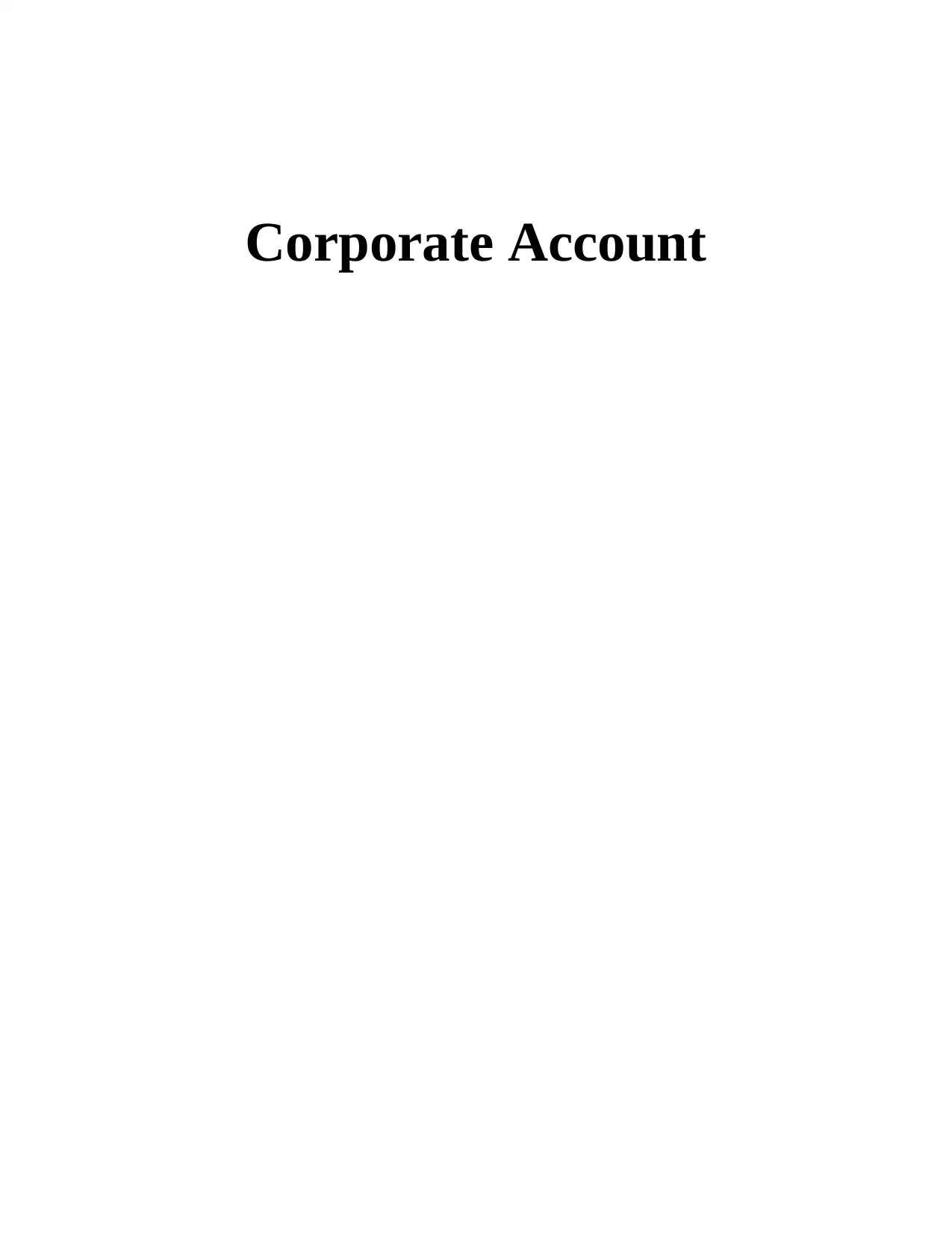
Corporate Account
Paraphrase This Document
Need a fresh take? Get an instant paraphrase of this document with our AI Paraphraser
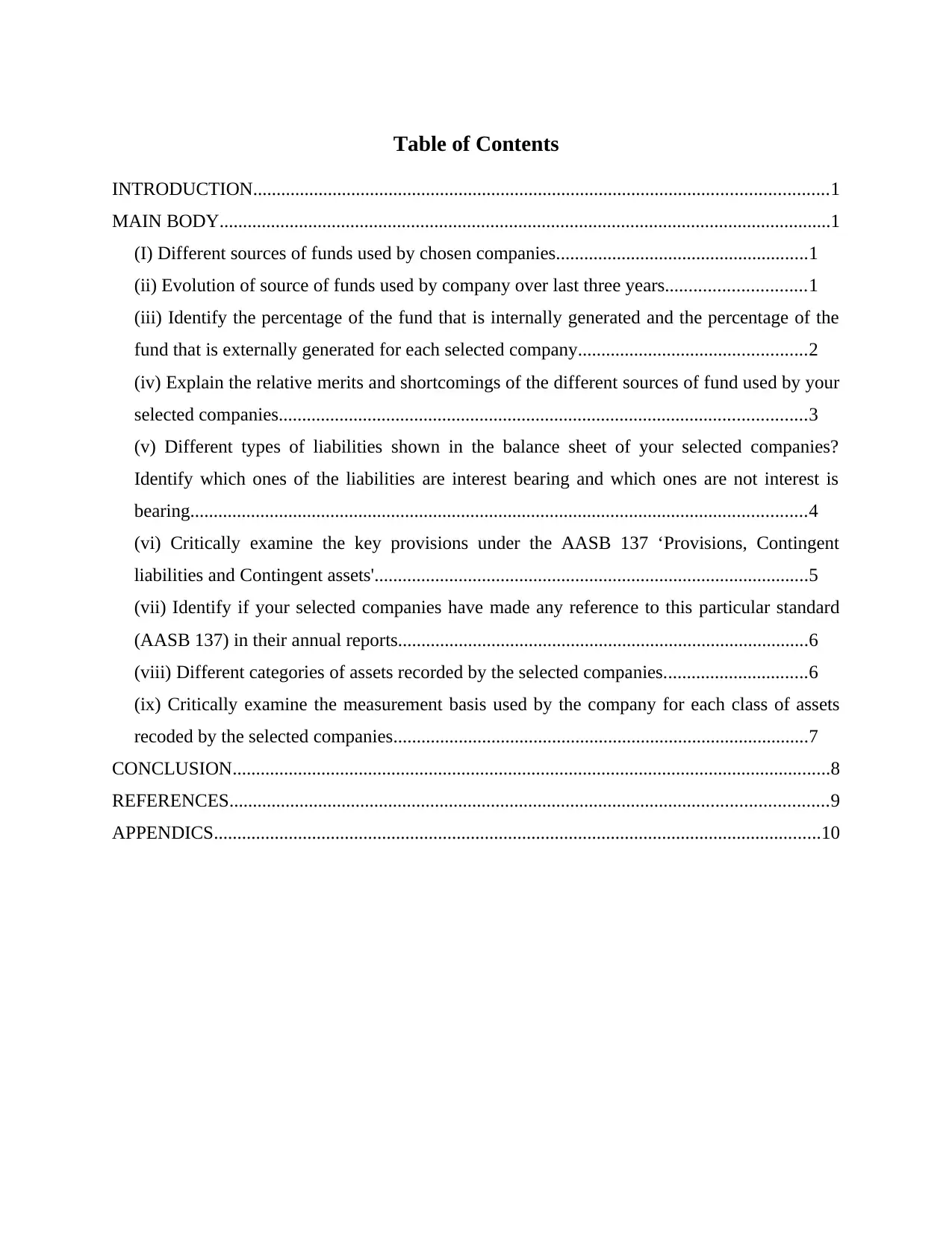
Table of Contents
INTRODUCTION...........................................................................................................................1
MAIN BODY...................................................................................................................................1
(I) Different sources of funds used by chosen companies......................................................1
(ii) Evolution of source of funds used by company over last three years..............................1
(iii) Identify the percentage of the fund that is internally generated and the percentage of the
fund that is externally generated for each selected company.................................................2
(iv) Explain the relative merits and shortcomings of the different sources of fund used by your
selected companies.................................................................................................................3
(v) Different types of liabilities shown in the balance sheet of your selected companies?
Identify which ones of the liabilities are interest bearing and which ones are not interest is
bearing....................................................................................................................................4
(vi) Critically examine the key provisions under the AASB 137 ‘Provisions, Contingent
liabilities and Contingent assets'.............................................................................................5
(vii) Identify if your selected companies have made any reference to this particular standard
(AASB 137) in their annual reports........................................................................................6
(viii) Different categories of assets recorded by the selected companies...............................6
(ix) Critically examine the measurement basis used by the company for each class of assets
recoded by the selected companies.........................................................................................7
CONCLUSION................................................................................................................................8
REFERENCES................................................................................................................................9
APPENDICS..................................................................................................................................10
INTRODUCTION...........................................................................................................................1
MAIN BODY...................................................................................................................................1
(I) Different sources of funds used by chosen companies......................................................1
(ii) Evolution of source of funds used by company over last three years..............................1
(iii) Identify the percentage of the fund that is internally generated and the percentage of the
fund that is externally generated for each selected company.................................................2
(iv) Explain the relative merits and shortcomings of the different sources of fund used by your
selected companies.................................................................................................................3
(v) Different types of liabilities shown in the balance sheet of your selected companies?
Identify which ones of the liabilities are interest bearing and which ones are not interest is
bearing....................................................................................................................................4
(vi) Critically examine the key provisions under the AASB 137 ‘Provisions, Contingent
liabilities and Contingent assets'.............................................................................................5
(vii) Identify if your selected companies have made any reference to this particular standard
(AASB 137) in their annual reports........................................................................................6
(viii) Different categories of assets recorded by the selected companies...............................6
(ix) Critically examine the measurement basis used by the company for each class of assets
recoded by the selected companies.........................................................................................7
CONCLUSION................................................................................................................................8
REFERENCES................................................................................................................................9
APPENDICS..................................................................................................................................10
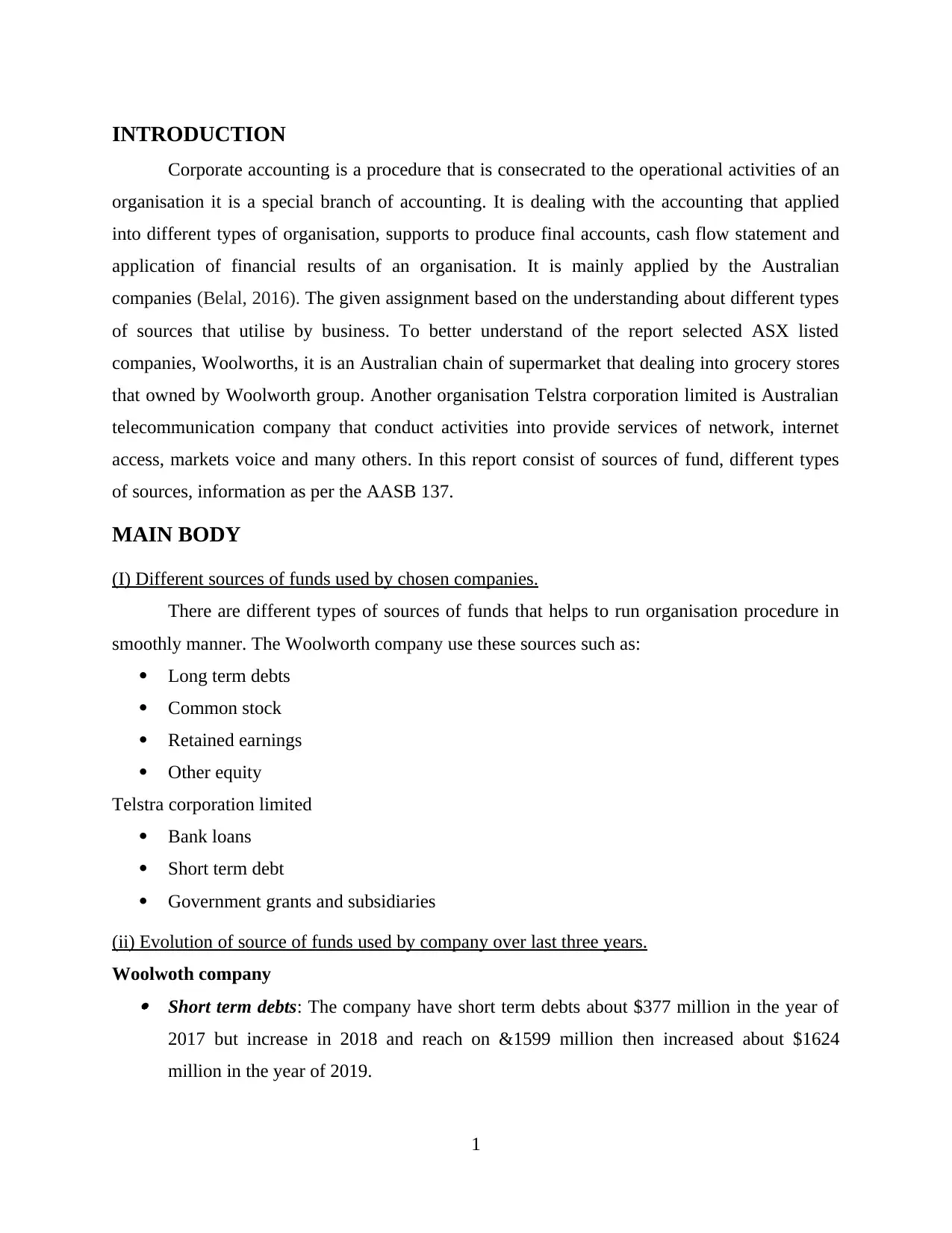
INTRODUCTION
Corporate accounting is a procedure that is consecrated to the operational activities of an
organisation it is a special branch of accounting. It is dealing with the accounting that applied
into different types of organisation, supports to produce final accounts, cash flow statement and
application of financial results of an organisation. It is mainly applied by the Australian
companies (Belal, 2016). The given assignment based on the understanding about different types
of sources that utilise by business. To better understand of the report selected ASX listed
companies, Woolworths, it is an Australian chain of supermarket that dealing into grocery stores
that owned by Woolworth group. Another organisation Telstra corporation limited is Australian
telecommunication company that conduct activities into provide services of network, internet
access, markets voice and many others. In this report consist of sources of fund, different types
of sources, information as per the AASB 137.
MAIN BODY
(I) Different sources of funds used by chosen companies.
There are different types of sources of funds that helps to run organisation procedure in
smoothly manner. The Woolworth company use these sources such as:
Long term debts
Common stock
Retained earnings
Other equity
Telstra corporation limited
Bank loans
Short term debt
Government grants and subsidiaries
(ii) Evolution of source of funds used by company over last three years.
Woolwoth company Short term debts: The company have short term debts about $377 million in the year of
2017 but increase in 2018 and reach on &1599 million then increased about $1624
million in the year of 2019.
1
Corporate accounting is a procedure that is consecrated to the operational activities of an
organisation it is a special branch of accounting. It is dealing with the accounting that applied
into different types of organisation, supports to produce final accounts, cash flow statement and
application of financial results of an organisation. It is mainly applied by the Australian
companies (Belal, 2016). The given assignment based on the understanding about different types
of sources that utilise by business. To better understand of the report selected ASX listed
companies, Woolworths, it is an Australian chain of supermarket that dealing into grocery stores
that owned by Woolworth group. Another organisation Telstra corporation limited is Australian
telecommunication company that conduct activities into provide services of network, internet
access, markets voice and many others. In this report consist of sources of fund, different types
of sources, information as per the AASB 137.
MAIN BODY
(I) Different sources of funds used by chosen companies.
There are different types of sources of funds that helps to run organisation procedure in
smoothly manner. The Woolworth company use these sources such as:
Long term debts
Common stock
Retained earnings
Other equity
Telstra corporation limited
Bank loans
Short term debt
Government grants and subsidiaries
(ii) Evolution of source of funds used by company over last three years.
Woolwoth company Short term debts: The company have short term debts about $377 million in the year of
2017 but increase in 2018 and reach on &1599 million then increased about $1624
million in the year of 2019.
1
⊘ This is a preview!⊘
Do you want full access?
Subscribe today to unlock all pages.

Trusted by 1+ million students worldwide
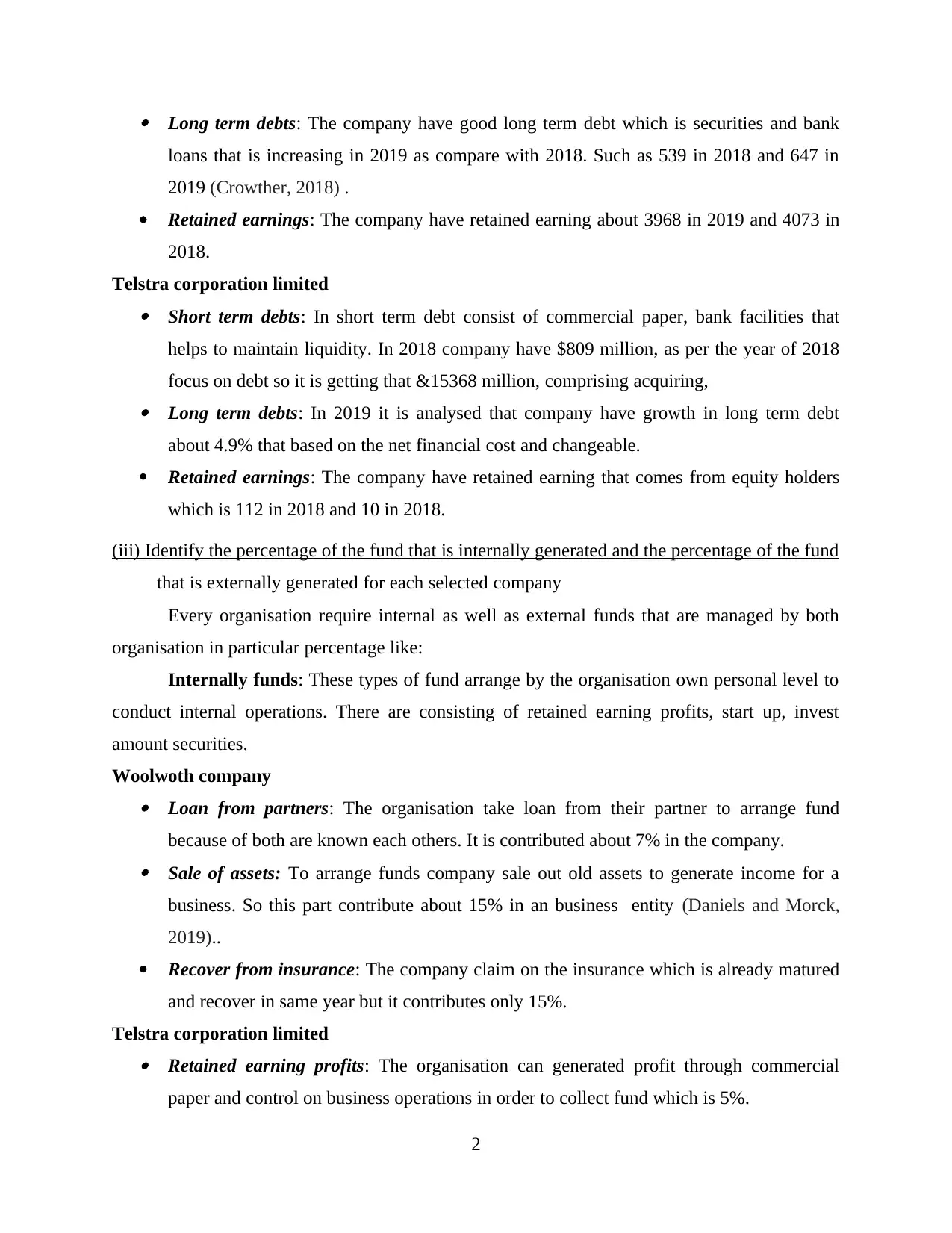
Long term debts: The company have good long term debt which is securities and bank
loans that is increasing in 2019 as compare with 2018. Such as 539 in 2018 and 647 in
2019 (Crowther, 2018) .
Retained earnings: The company have retained earning about 3968 in 2019 and 4073 in
2018.
Telstra corporation limited Short term debts: In short term debt consist of commercial paper, bank facilities that
helps to maintain liquidity. In 2018 company have $809 million, as per the year of 2018
focus on debt so it is getting that &15368 million, comprising acquiring, Long term debts: In 2019 it is analysed that company have growth in long term debt
about 4.9% that based on the net financial cost and changeable.
Retained earnings: The company have retained earning that comes from equity holders
which is 112 in 2018 and 10 in 2018.
(iii) Identify the percentage of the fund that is internally generated and the percentage of the fund
that is externally generated for each selected company
Every organisation require internal as well as external funds that are managed by both
organisation in particular percentage like:
Internally funds: These types of fund arrange by the organisation own personal level to
conduct internal operations. There are consisting of retained earning profits, start up, invest
amount securities.
Woolwoth company Loan from partners: The organisation take loan from their partner to arrange fund
because of both are known each others. It is contributed about 7% in the company. Sale of assets: To arrange funds company sale out old assets to generate income for a
business. So this part contribute about 15% in an business entity (Daniels and Morck,
2019)..
Recover from insurance: The company claim on the insurance which is already matured
and recover in same year but it contributes only 15%.
Telstra corporation limited Retained earning profits: The organisation can generated profit through commercial
paper and control on business operations in order to collect fund which is 5%.
2
loans that is increasing in 2019 as compare with 2018. Such as 539 in 2018 and 647 in
2019 (Crowther, 2018) .
Retained earnings: The company have retained earning about 3968 in 2019 and 4073 in
2018.
Telstra corporation limited Short term debts: In short term debt consist of commercial paper, bank facilities that
helps to maintain liquidity. In 2018 company have $809 million, as per the year of 2018
focus on debt so it is getting that &15368 million, comprising acquiring, Long term debts: In 2019 it is analysed that company have growth in long term debt
about 4.9% that based on the net financial cost and changeable.
Retained earnings: The company have retained earning that comes from equity holders
which is 112 in 2018 and 10 in 2018.
(iii) Identify the percentage of the fund that is internally generated and the percentage of the fund
that is externally generated for each selected company
Every organisation require internal as well as external funds that are managed by both
organisation in particular percentage like:
Internally funds: These types of fund arrange by the organisation own personal level to
conduct internal operations. There are consisting of retained earning profits, start up, invest
amount securities.
Woolwoth company Loan from partners: The organisation take loan from their partner to arrange fund
because of both are known each others. It is contributed about 7% in the company. Sale of assets: To arrange funds company sale out old assets to generate income for a
business. So this part contribute about 15% in an business entity (Daniels and Morck,
2019)..
Recover from insurance: The company claim on the insurance which is already matured
and recover in same year but it contributes only 15%.
Telstra corporation limited Retained earning profits: The organisation can generated profit through commercial
paper and control on business operations in order to collect fund which is 5%.
2
Paraphrase This Document
Need a fresh take? Get an instant paraphrase of this document with our AI Paraphraser
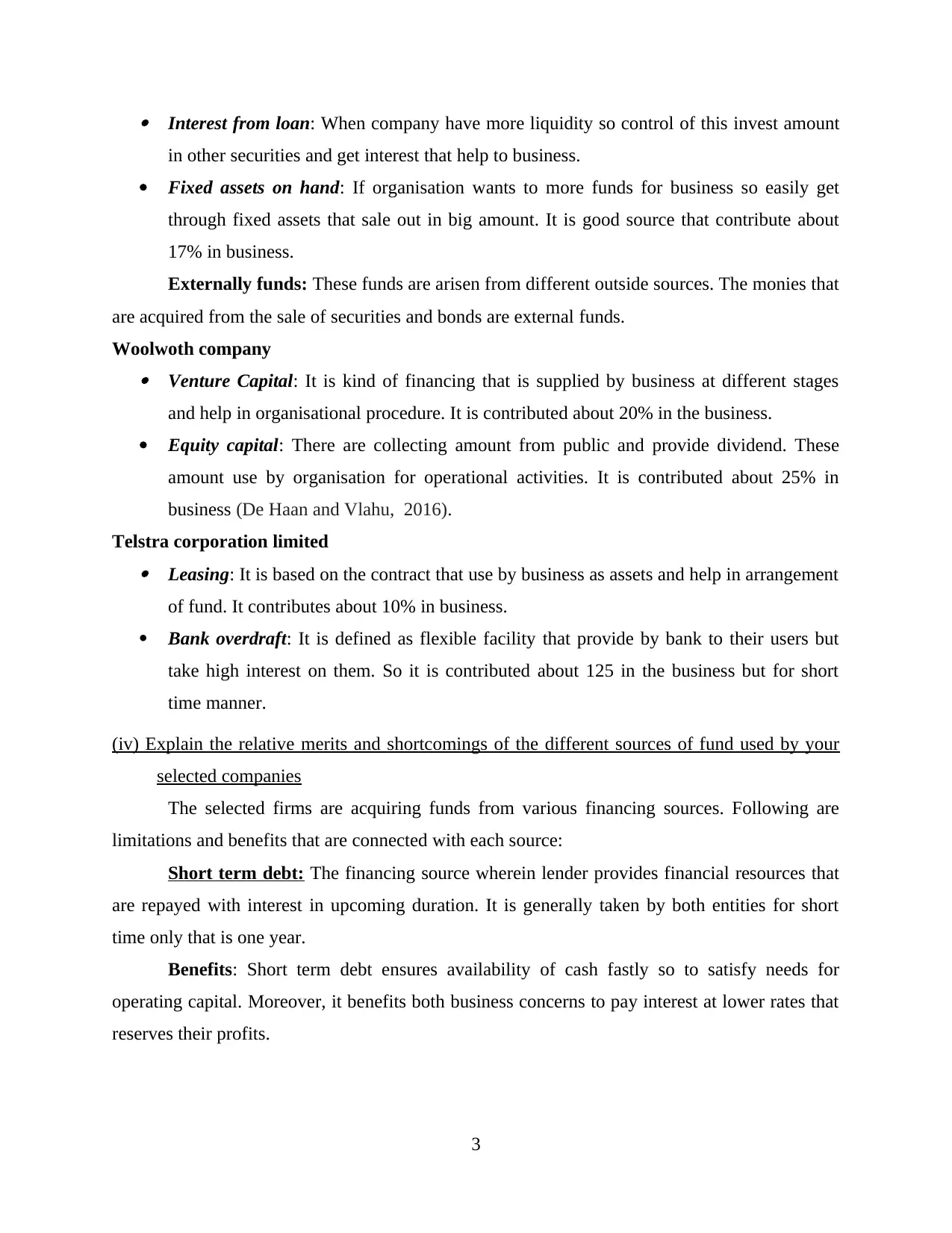
Interest from loan: When company have more liquidity so control of this invest amount
in other securities and get interest that help to business.
Fixed assets on hand: If organisation wants to more funds for business so easily get
through fixed assets that sale out in big amount. It is good source that contribute about
17% in business.
Externally funds: These funds are arisen from different outside sources. The monies that
are acquired from the sale of securities and bonds are external funds.
Woolwoth company Venture Capital: It is kind of financing that is supplied by business at different stages
and help in organisational procedure. It is contributed about 20% in the business.
Equity capital: There are collecting amount from public and provide dividend. These
amount use by organisation for operational activities. It is contributed about 25% in
business (De Haan and Vlahu, 2016).
Telstra corporation limited Leasing: It is based on the contract that use by business as assets and help in arrangement
of fund. It contributes about 10% in business.
Bank overdraft: It is defined as flexible facility that provide by bank to their users but
take high interest on them. So it is contributed about 125 in the business but for short
time manner.
(iv) Explain the relative merits and shortcomings of the different sources of fund used by your
selected companies
The selected firms are acquiring funds from various financing sources. Following are
limitations and benefits that are connected with each source:
Short term debt: The financing source wherein lender provides financial resources that
are repayed with interest in upcoming duration. It is generally taken by both entities for short
time only that is one year.
Benefits: Short term debt ensures availability of cash fastly so to satisfy needs for
operating capital. Moreover, it benefits both business concerns to pay interest at lower rates that
reserves their profits.
3
in other securities and get interest that help to business.
Fixed assets on hand: If organisation wants to more funds for business so easily get
through fixed assets that sale out in big amount. It is good source that contribute about
17% in business.
Externally funds: These funds are arisen from different outside sources. The monies that
are acquired from the sale of securities and bonds are external funds.
Woolwoth company Venture Capital: It is kind of financing that is supplied by business at different stages
and help in organisational procedure. It is contributed about 20% in the business.
Equity capital: There are collecting amount from public and provide dividend. These
amount use by organisation for operational activities. It is contributed about 25% in
business (De Haan and Vlahu, 2016).
Telstra corporation limited Leasing: It is based on the contract that use by business as assets and help in arrangement
of fund. It contributes about 10% in business.
Bank overdraft: It is defined as flexible facility that provide by bank to their users but
take high interest on them. So it is contributed about 125 in the business but for short
time manner.
(iv) Explain the relative merits and shortcomings of the different sources of fund used by your
selected companies
The selected firms are acquiring funds from various financing sources. Following are
limitations and benefits that are connected with each source:
Short term debt: The financing source wherein lender provides financial resources that
are repayed with interest in upcoming duration. It is generally taken by both entities for short
time only that is one year.
Benefits: Short term debt ensures availability of cash fastly so to satisfy needs for
operating capital. Moreover, it benefits both business concerns to pay interest at lower rates that
reserves their profits.
3
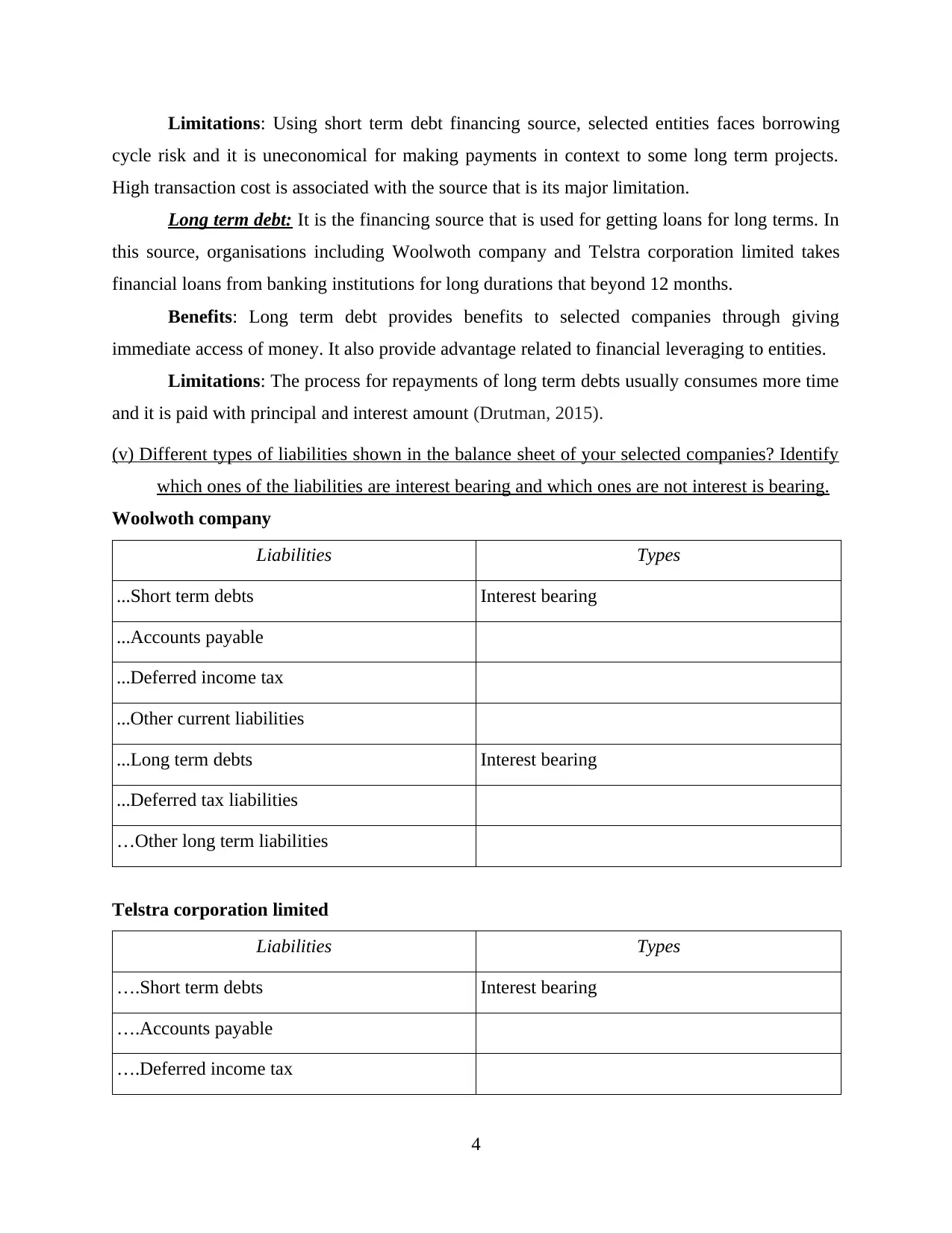
Limitations: Using short term debt financing source, selected entities faces borrowing
cycle risk and it is uneconomical for making payments in context to some long term projects.
High transaction cost is associated with the source that is its major limitation.
Long term debt: It is the financing source that is used for getting loans for long terms. In
this source, organisations including Woolwoth company and Telstra corporation limited takes
financial loans from banking institutions for long durations that beyond 12 months.
Benefits: Long term debt provides benefits to selected companies through giving
immediate access of money. It also provide advantage related to financial leveraging to entities.
Limitations: The process for repayments of long term debts usually consumes more time
and it is paid with principal and interest amount (Drutman, 2015).
(v) Different types of liabilities shown in the balance sheet of your selected companies? Identify
which ones of the liabilities are interest bearing and which ones are not interest is bearing.
Woolwoth company
Liabilities Types
...Short term debts Interest bearing
...Accounts payable
...Deferred income tax
...Other current liabilities
...Long term debts Interest bearing
...Deferred tax liabilities
…Other long term liabilities
Telstra corporation limited
Liabilities Types
….Short term debts Interest bearing
….Accounts payable
….Deferred income tax
4
cycle risk and it is uneconomical for making payments in context to some long term projects.
High transaction cost is associated with the source that is its major limitation.
Long term debt: It is the financing source that is used for getting loans for long terms. In
this source, organisations including Woolwoth company and Telstra corporation limited takes
financial loans from banking institutions for long durations that beyond 12 months.
Benefits: Long term debt provides benefits to selected companies through giving
immediate access of money. It also provide advantage related to financial leveraging to entities.
Limitations: The process for repayments of long term debts usually consumes more time
and it is paid with principal and interest amount (Drutman, 2015).
(v) Different types of liabilities shown in the balance sheet of your selected companies? Identify
which ones of the liabilities are interest bearing and which ones are not interest is bearing.
Woolwoth company
Liabilities Types
...Short term debts Interest bearing
...Accounts payable
...Deferred income tax
...Other current liabilities
...Long term debts Interest bearing
...Deferred tax liabilities
…Other long term liabilities
Telstra corporation limited
Liabilities Types
….Short term debts Interest bearing
….Accounts payable
….Deferred income tax
4
⊘ This is a preview!⊘
Do you want full access?
Subscribe today to unlock all pages.

Trusted by 1+ million students worldwide
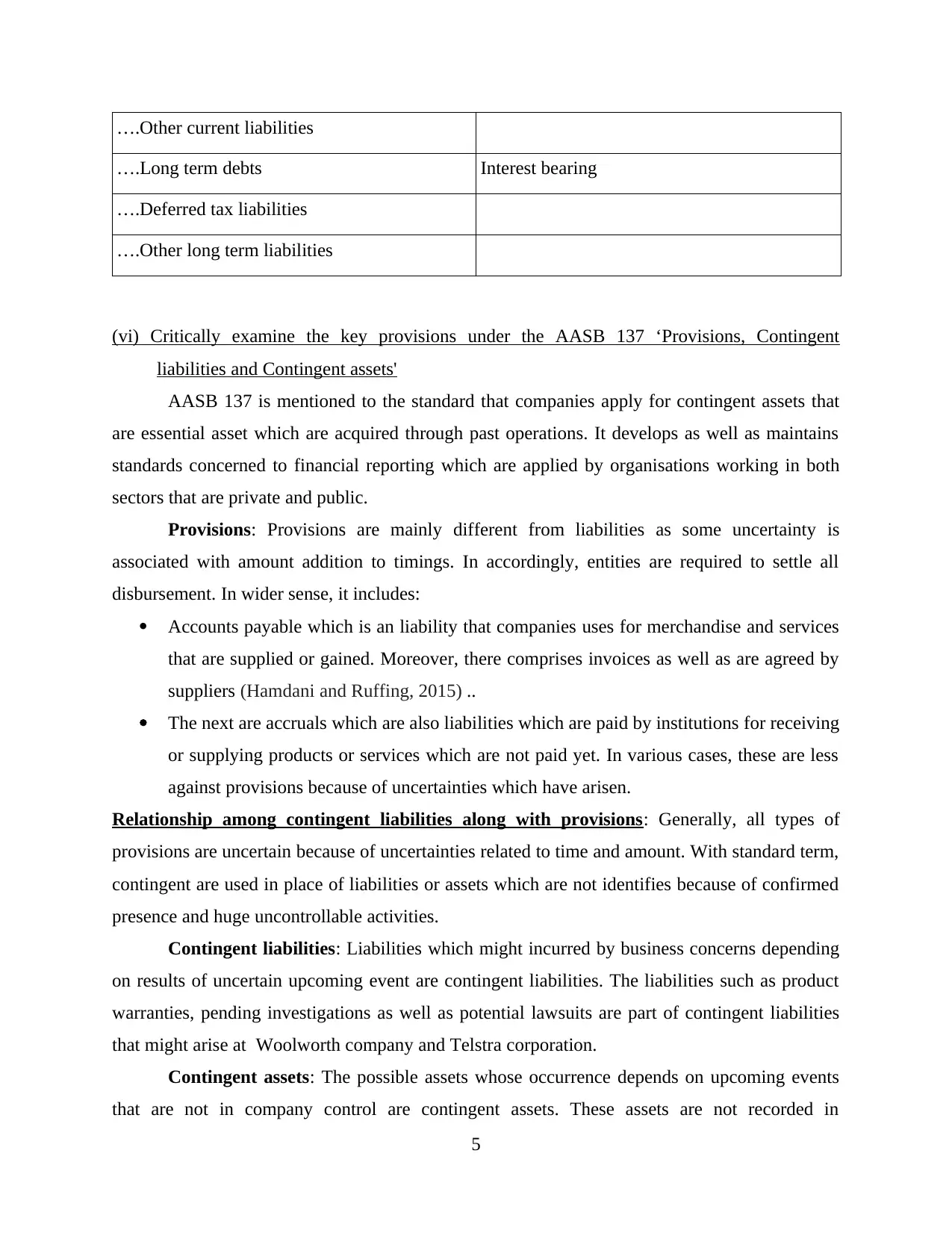
….Other current liabilities
….Long term debts Interest bearing
….Deferred tax liabilities
….Other long term liabilities
(vi) Critically examine the key provisions under the AASB 137 ‘Provisions, Contingent
liabilities and Contingent assets'
AASB 137 is mentioned to the standard that companies apply for contingent assets that
are essential asset which are acquired through past operations. It develops as well as maintains
standards concerned to financial reporting which are applied by organisations working in both
sectors that are private and public.
Provisions: Provisions are mainly different from liabilities as some uncertainty is
associated with amount addition to timings. In accordingly, entities are required to settle all
disbursement. In wider sense, it includes:
Accounts payable which is an liability that companies uses for merchandise and services
that are supplied or gained. Moreover, there comprises invoices as well as are agreed by
suppliers (Hamdani and Ruffing, 2015) ..
The next are accruals which are also liabilities which are paid by institutions for receiving
or supplying products or services which are not paid yet. In various cases, these are less
against provisions because of uncertainties which have arisen.
Relationship among contingent liabilities along with provisions: Generally, all types of
provisions are uncertain because of uncertainties related to time and amount. With standard term,
contingent are used in place of liabilities or assets which are not identifies because of confirmed
presence and huge uncontrollable activities.
Contingent liabilities: Liabilities which might incurred by business concerns depending
on results of uncertain upcoming event are contingent liabilities. The liabilities such as product
warranties, pending investigations as well as potential lawsuits are part of contingent liabilities
that might arise at Woolworth company and Telstra corporation.
Contingent assets: The possible assets whose occurrence depends on upcoming events
that are not in company control are contingent assets. These assets are not recorded in
5
….Long term debts Interest bearing
….Deferred tax liabilities
….Other long term liabilities
(vi) Critically examine the key provisions under the AASB 137 ‘Provisions, Contingent
liabilities and Contingent assets'
AASB 137 is mentioned to the standard that companies apply for contingent assets that
are essential asset which are acquired through past operations. It develops as well as maintains
standards concerned to financial reporting which are applied by organisations working in both
sectors that are private and public.
Provisions: Provisions are mainly different from liabilities as some uncertainty is
associated with amount addition to timings. In accordingly, entities are required to settle all
disbursement. In wider sense, it includes:
Accounts payable which is an liability that companies uses for merchandise and services
that are supplied or gained. Moreover, there comprises invoices as well as are agreed by
suppliers (Hamdani and Ruffing, 2015) ..
The next are accruals which are also liabilities which are paid by institutions for receiving
or supplying products or services which are not paid yet. In various cases, these are less
against provisions because of uncertainties which have arisen.
Relationship among contingent liabilities along with provisions: Generally, all types of
provisions are uncertain because of uncertainties related to time and amount. With standard term,
contingent are used in place of liabilities or assets which are not identifies because of confirmed
presence and huge uncontrollable activities.
Contingent liabilities: Liabilities which might incurred by business concerns depending
on results of uncertain upcoming event are contingent liabilities. The liabilities such as product
warranties, pending investigations as well as potential lawsuits are part of contingent liabilities
that might arise at Woolworth company and Telstra corporation.
Contingent assets: The possible assets whose occurrence depends on upcoming events
that are not in company control are contingent assets. These assets are not recorded in
5
Paraphrase This Document
Need a fresh take? Get an instant paraphrase of this document with our AI Paraphraser
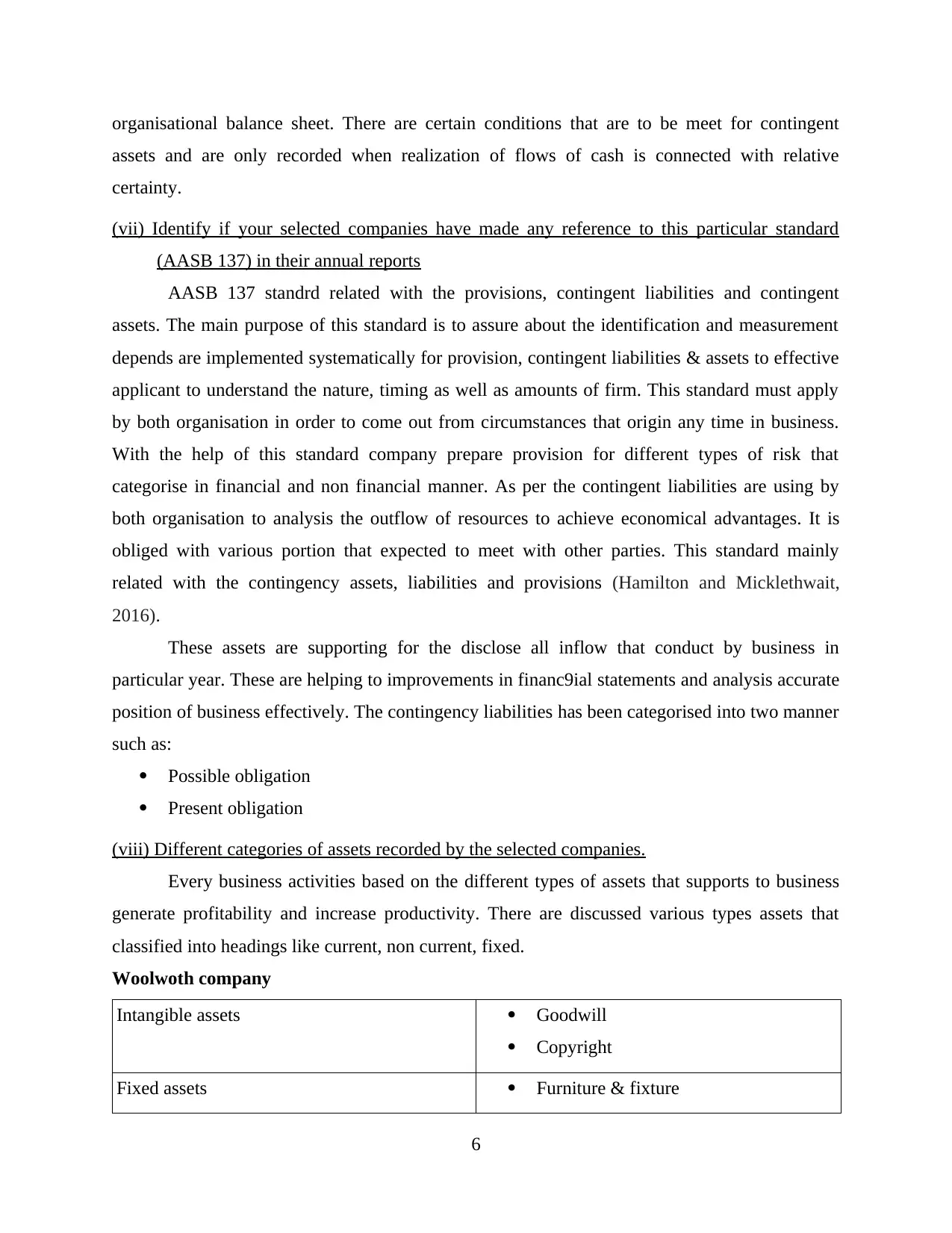
organisational balance sheet. There are certain conditions that are to be meet for contingent
assets and are only recorded when realization of flows of cash is connected with relative
certainty.
(vii) Identify if your selected companies have made any reference to this particular standard
(AASB 137) in their annual reports
AASB 137 standrd related with the provisions, contingent liabilities and contingent
assets. The main purpose of this standard is to assure about the identification and measurement
depends are implemented systematically for provision, contingent liabilities & assets to effective
applicant to understand the nature, timing as well as amounts of firm. This standard must apply
by both organisation in order to come out from circumstances that origin any time in business.
With the help of this standard company prepare provision for different types of risk that
categorise in financial and non financial manner. As per the contingent liabilities are using by
both organisation to analysis the outflow of resources to achieve economical advantages. It is
obliged with various portion that expected to meet with other parties. This standard mainly
related with the contingency assets, liabilities and provisions (Hamilton and Micklethwait,
2016).
These assets are supporting for the disclose all inflow that conduct by business in
particular year. These are helping to improvements in financ9ial statements and analysis accurate
position of business effectively. The contingency liabilities has been categorised into two manner
such as:
Possible obligation
Present obligation
(viii) Different categories of assets recorded by the selected companies.
Every business activities based on the different types of assets that supports to business
generate profitability and increase productivity. There are discussed various types assets that
classified into headings like current, non current, fixed.
Woolwoth company
Intangible assets Goodwill
Copyright
Fixed assets Furniture & fixture
6
assets and are only recorded when realization of flows of cash is connected with relative
certainty.
(vii) Identify if your selected companies have made any reference to this particular standard
(AASB 137) in their annual reports
AASB 137 standrd related with the provisions, contingent liabilities and contingent
assets. The main purpose of this standard is to assure about the identification and measurement
depends are implemented systematically for provision, contingent liabilities & assets to effective
applicant to understand the nature, timing as well as amounts of firm. This standard must apply
by both organisation in order to come out from circumstances that origin any time in business.
With the help of this standard company prepare provision for different types of risk that
categorise in financial and non financial manner. As per the contingent liabilities are using by
both organisation to analysis the outflow of resources to achieve economical advantages. It is
obliged with various portion that expected to meet with other parties. This standard mainly
related with the contingency assets, liabilities and provisions (Hamilton and Micklethwait,
2016).
These assets are supporting for the disclose all inflow that conduct by business in
particular year. These are helping to improvements in financ9ial statements and analysis accurate
position of business effectively. The contingency liabilities has been categorised into two manner
such as:
Possible obligation
Present obligation
(viii) Different categories of assets recorded by the selected companies.
Every business activities based on the different types of assets that supports to business
generate profitability and increase productivity. There are discussed various types assets that
classified into headings like current, non current, fixed.
Woolwoth company
Intangible assets Goodwill
Copyright
Fixed assets Furniture & fixture
6
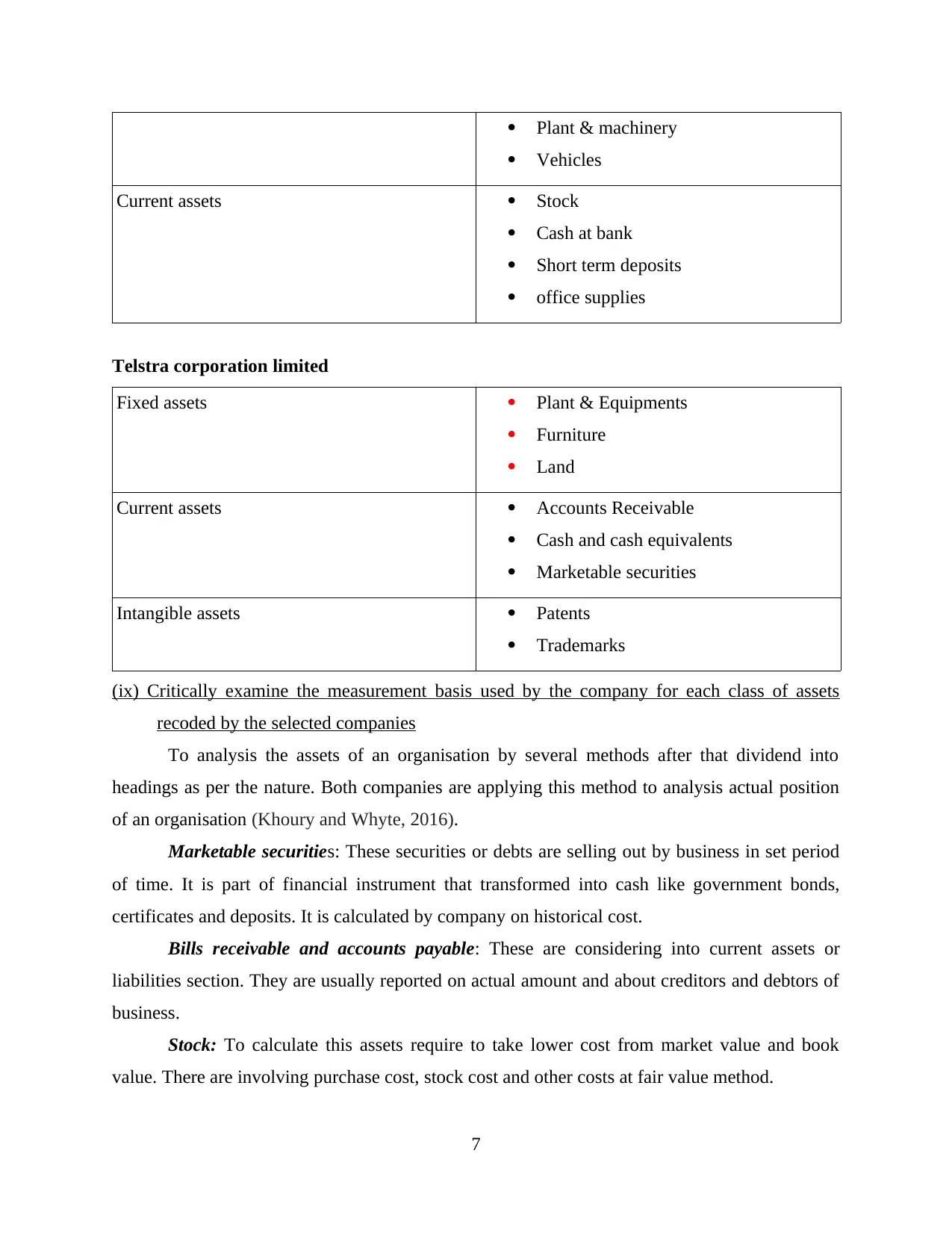
Plant & machinery
Vehicles
Current assets Stock
Cash at bank
Short term deposits
office supplies
Telstra corporation limited
Fixed assets Plant & Equipments
Furniture
Land
Current assets Accounts Receivable
Cash and cash equivalents
Marketable securities
Intangible assets Patents
Trademarks
(ix) Critically examine the measurement basis used by the company for each class of assets
recoded by the selected companies
To analysis the assets of an organisation by several methods after that dividend into
headings as per the nature. Both companies are applying this method to analysis actual position
of an organisation (Khoury and Whyte, 2016).
Marketable securities: These securities or debts are selling out by business in set period
of time. It is part of financial instrument that transformed into cash like government bonds,
certificates and deposits. It is calculated by company on historical cost.
Bills receivable and accounts payable: These are considering into current assets or
liabilities section. They are usually reported on actual amount and about creditors and debtors of
business.
Stock: To calculate this assets require to take lower cost from market value and book
value. There are involving purchase cost, stock cost and other costs at fair value method.
7
Vehicles
Current assets Stock
Cash at bank
Short term deposits
office supplies
Telstra corporation limited
Fixed assets Plant & Equipments
Furniture
Land
Current assets Accounts Receivable
Cash and cash equivalents
Marketable securities
Intangible assets Patents
Trademarks
(ix) Critically examine the measurement basis used by the company for each class of assets
recoded by the selected companies
To analysis the assets of an organisation by several methods after that dividend into
headings as per the nature. Both companies are applying this method to analysis actual position
of an organisation (Khoury and Whyte, 2016).
Marketable securities: These securities or debts are selling out by business in set period
of time. It is part of financial instrument that transformed into cash like government bonds,
certificates and deposits. It is calculated by company on historical cost.
Bills receivable and accounts payable: These are considering into current assets or
liabilities section. They are usually reported on actual amount and about creditors and debtors of
business.
Stock: To calculate this assets require to take lower cost from market value and book
value. There are involving purchase cost, stock cost and other costs at fair value method.
7
⊘ This is a preview!⊘
Do you want full access?
Subscribe today to unlock all pages.

Trusted by 1+ million students worldwide
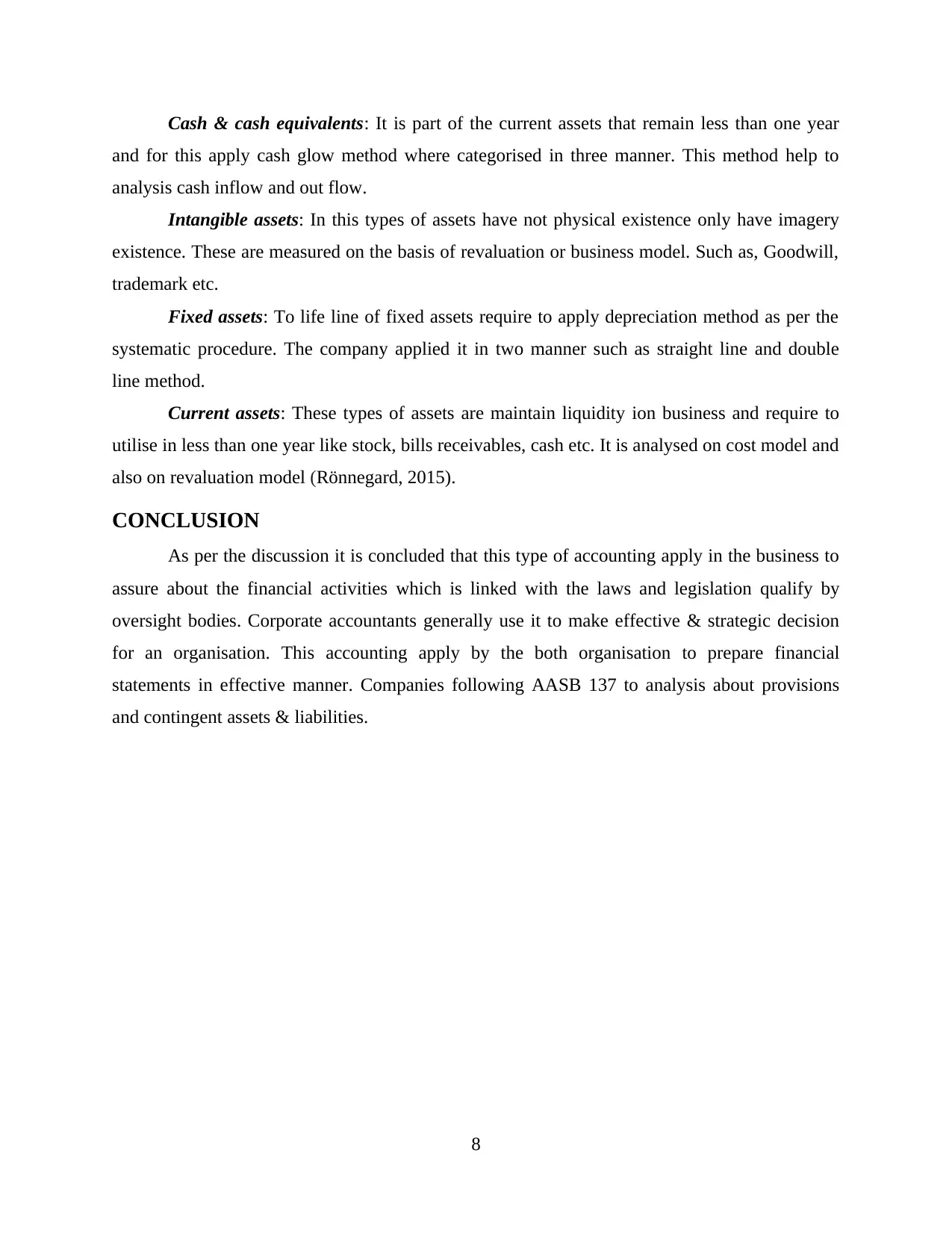
Cash & cash equivalents: It is part of the current assets that remain less than one year
and for this apply cash glow method where categorised in three manner. This method help to
analysis cash inflow and out flow.
Intangible assets: In this types of assets have not physical existence only have imagery
existence. These are measured on the basis of revaluation or business model. Such as, Goodwill,
trademark etc.
Fixed assets: To life line of fixed assets require to apply depreciation method as per the
systematic procedure. The company applied it in two manner such as straight line and double
line method.
Current assets: These types of assets are maintain liquidity ion business and require to
utilise in less than one year like stock, bills receivables, cash etc. It is analysed on cost model and
also on revaluation model (Rönnegard, 2015).
CONCLUSION
As per the discussion it is concluded that this type of accounting apply in the business to
assure about the financial activities which is linked with the laws and legislation qualify by
oversight bodies. Corporate accountants generally use it to make effective & strategic decision
for an organisation. This accounting apply by the both organisation to prepare financial
statements in effective manner. Companies following AASB 137 to analysis about provisions
and contingent assets & liabilities.
8
and for this apply cash glow method where categorised in three manner. This method help to
analysis cash inflow and out flow.
Intangible assets: In this types of assets have not physical existence only have imagery
existence. These are measured on the basis of revaluation or business model. Such as, Goodwill,
trademark etc.
Fixed assets: To life line of fixed assets require to apply depreciation method as per the
systematic procedure. The company applied it in two manner such as straight line and double
line method.
Current assets: These types of assets are maintain liquidity ion business and require to
utilise in less than one year like stock, bills receivables, cash etc. It is analysed on cost model and
also on revaluation model (Rönnegard, 2015).
CONCLUSION
As per the discussion it is concluded that this type of accounting apply in the business to
assure about the financial activities which is linked with the laws and legislation qualify by
oversight bodies. Corporate accountants generally use it to make effective & strategic decision
for an organisation. This accounting apply by the both organisation to prepare financial
statements in effective manner. Companies following AASB 137 to analysis about provisions
and contingent assets & liabilities.
8
Paraphrase This Document
Need a fresh take? Get an instant paraphrase of this document with our AI Paraphraser
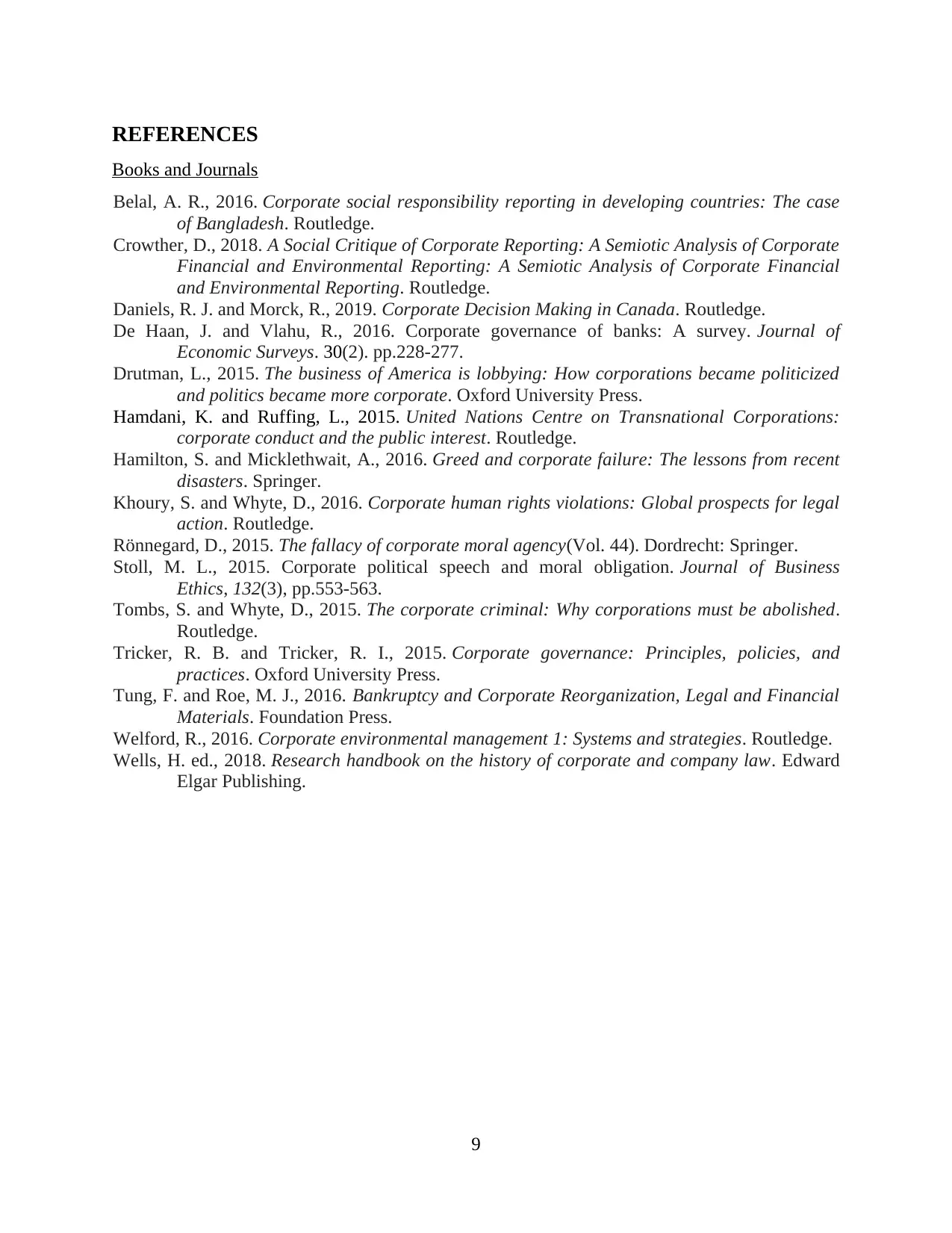
REFERENCES
Books and Journals
Belal, A. R., 2016. Corporate social responsibility reporting in developing countries: The case
of Bangladesh. Routledge.
Crowther, D., 2018. A Social Critique of Corporate Reporting: A Semiotic Analysis of Corporate
Financial and Environmental Reporting: A Semiotic Analysis of Corporate Financial
and Environmental Reporting. Routledge.
Daniels, R. J. and Morck, R., 2019. Corporate Decision Making in Canada. Routledge.
De Haan, J. and Vlahu, R., 2016. Corporate governance of banks: A survey. Journal of
Economic Surveys. 30(2). pp.228-277.
Drutman, L., 2015. The business of America is lobbying: How corporations became politicized
and politics became more corporate. Oxford University Press.
Hamdani, K. and Ruffing, L., 2015. United Nations Centre on Transnational Corporations:
corporate conduct and the public interest. Routledge.
Hamilton, S. and Micklethwait, A., 2016. Greed and corporate failure: The lessons from recent
disasters. Springer.
Khoury, S. and Whyte, D., 2016. Corporate human rights violations: Global prospects for legal
action. Routledge.
Rönnegard, D., 2015. The fallacy of corporate moral agency(Vol. 44). Dordrecht: Springer.
Stoll, M. L., 2015. Corporate political speech and moral obligation. Journal of Business
Ethics, 132(3), pp.553-563.
Tombs, S. and Whyte, D., 2015. The corporate criminal: Why corporations must be abolished.
Routledge.
Tricker, R. B. and Tricker, R. I., 2015. Corporate governance: Principles, policies, and
practices. Oxford University Press.
Tung, F. and Roe, M. J., 2016. Bankruptcy and Corporate Reorganization, Legal and Financial
Materials. Foundation Press.
Welford, R., 2016. Corporate environmental management 1: Systems and strategies. Routledge.
Wells, H. ed., 2018. Research handbook on the history of corporate and company law. Edward
Elgar Publishing.
9
Books and Journals
Belal, A. R., 2016. Corporate social responsibility reporting in developing countries: The case
of Bangladesh. Routledge.
Crowther, D., 2018. A Social Critique of Corporate Reporting: A Semiotic Analysis of Corporate
Financial and Environmental Reporting: A Semiotic Analysis of Corporate Financial
and Environmental Reporting. Routledge.
Daniels, R. J. and Morck, R., 2019. Corporate Decision Making in Canada. Routledge.
De Haan, J. and Vlahu, R., 2016. Corporate governance of banks: A survey. Journal of
Economic Surveys. 30(2). pp.228-277.
Drutman, L., 2015. The business of America is lobbying: How corporations became politicized
and politics became more corporate. Oxford University Press.
Hamdani, K. and Ruffing, L., 2015. United Nations Centre on Transnational Corporations:
corporate conduct and the public interest. Routledge.
Hamilton, S. and Micklethwait, A., 2016. Greed and corporate failure: The lessons from recent
disasters. Springer.
Khoury, S. and Whyte, D., 2016. Corporate human rights violations: Global prospects for legal
action. Routledge.
Rönnegard, D., 2015. The fallacy of corporate moral agency(Vol. 44). Dordrecht: Springer.
Stoll, M. L., 2015. Corporate political speech and moral obligation. Journal of Business
Ethics, 132(3), pp.553-563.
Tombs, S. and Whyte, D., 2015. The corporate criminal: Why corporations must be abolished.
Routledge.
Tricker, R. B. and Tricker, R. I., 2015. Corporate governance: Principles, policies, and
practices. Oxford University Press.
Tung, F. and Roe, M. J., 2016. Bankruptcy and Corporate Reorganization, Legal and Financial
Materials. Foundation Press.
Welford, R., 2016. Corporate environmental management 1: Systems and strategies. Routledge.
Wells, H. ed., 2018. Research handbook on the history of corporate and company law. Edward
Elgar Publishing.
9
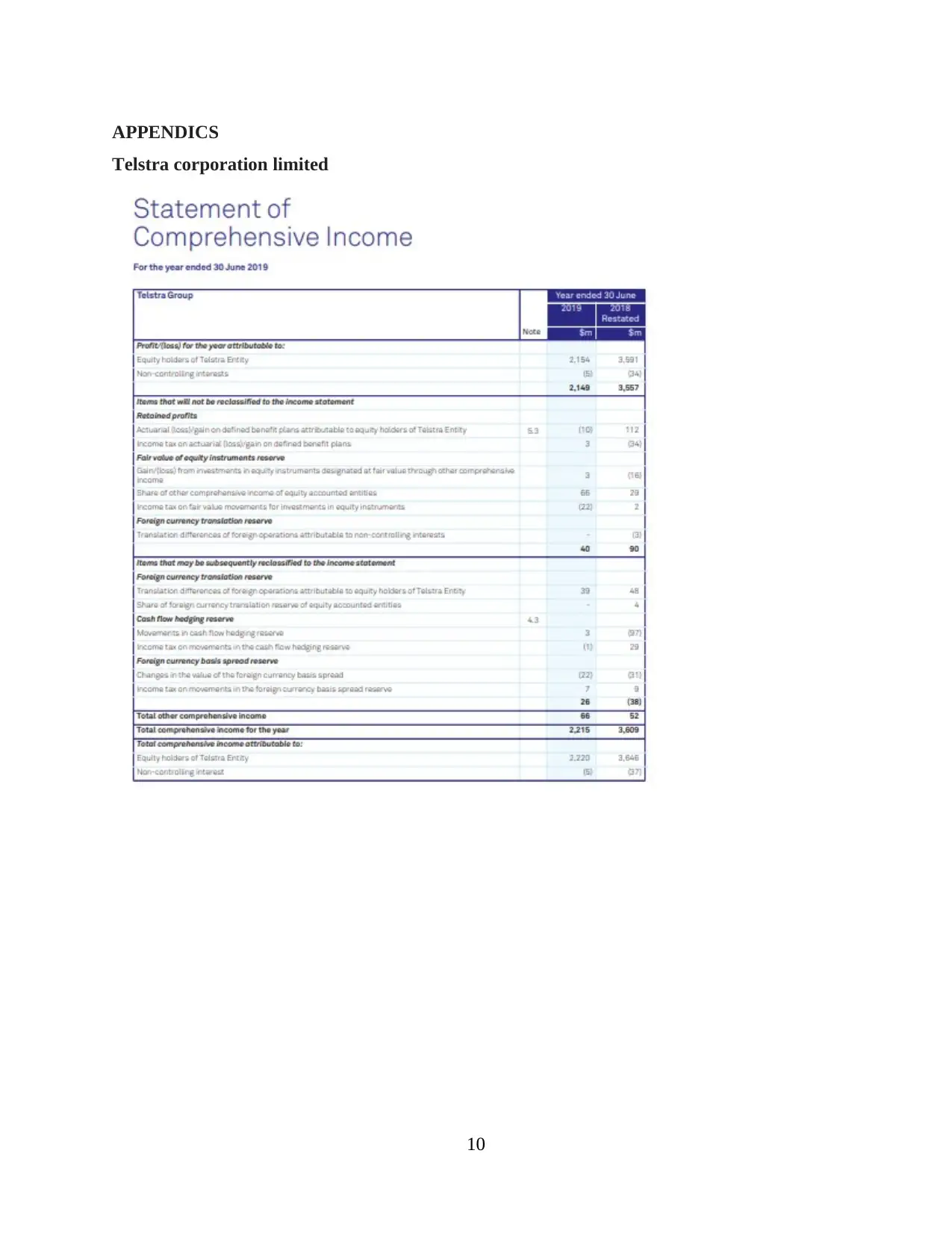
APPENDICS
Telstra corporation limited
10
Telstra corporation limited
10
⊘ This is a preview!⊘
Do you want full access?
Subscribe today to unlock all pages.

Trusted by 1+ million students worldwide
1 out of 21
Related Documents
Your All-in-One AI-Powered Toolkit for Academic Success.
+13062052269
info@desklib.com
Available 24*7 on WhatsApp / Email
![[object Object]](/_next/static/media/star-bottom.7253800d.svg)
Unlock your academic potential
Copyright © 2020–2025 A2Z Services. All Rights Reserved. Developed and managed by ZUCOL.





